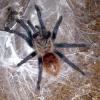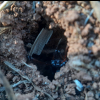So a month or two back I caught a C. nearcticus queen. For the first week or so she didn't lay any eggs. in fact, I noticed the first sign of offspring as a small larvae that appeared about a month after capture. I just checked on her and has a small pile of 3-4 eggs and larvae and 1 pupa, which she keeps separate from the rest. Now this isn't the weird part. Everyone knows that Camponotus pupae spin cocoons. Except this pupae is naked. It has no cocoon. I may be wrong about specific species, but it's definitely some species of Camponotus. She has the signature thorax shape of a carpenter ant queen. If someone could try to explain this, I would be grateful. Thank you.
- Formiculture.com
- Forums
- Gallery
- Members
- Member Map
- Chat



















